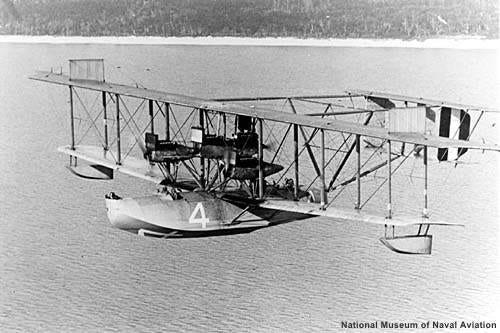May, 2019
On May 16, 1919, the NC-4 (a Curtiss “flying boat”) took off from Newfoundland en route to Lisbon, They were attempting the first transatlantic flight. When you think about transatlantic flights, it’s natural to assume that they’re nonstop, but this one was not. It was a flying boat, after all — the hull was built by the Herreshoff boatyard in Rhode Island — and it stopped several times for rest and repairs. In fact, although they departed Newfoundland on May 16, the mission had actually started on May 8 in New York.

It was a “mission” more than an adventure because the whole thing was a huge operation by the US Navy. At the start there were four identical aircraft — NC-1 through NC-4. NC-2 never took off from New York; the other planes needed repairs before they even started, and parts from NC-2 were used.
The NC-4 was a big machine, and carried a crew of 6 — two pilots, two engineers, a navigator, and a radio operator. They were able keep in radio contact, even though the radios of the day didn’t have transatlantic range, because the Navy had stationed ships in 50-mile intervals across the entire ocean. There was even a specially fitted “seaplane tender” ship that left early to meet the planes in Newfoundland, and later in England. The ships at sea were there to provide navigation assistance, too; they used searchlights and fired flares so the planes could find their way at night.
Visibility was a big problem on the flight; not only were they flying at night (very unusual for 1919), there were fog banks so thick that NC-1 and NC-3 turned back and “landed” on the ocean. NC-1 was damaged, but the crew was rescued by a passing cargo ship before NC-1 sank. NC-3 had engine problems and couldn’t take off again, but were able to taxi about 200 miles, where it was towed by one of the Navy ships. NC-4, though, made it to the Azores where they stopped for repairs. They had to wait for spare parts, and didn’t leave for Lisbon until May 27. Thirteen more navy ships were stationed along the Azores-to-Lisbon line, but for once the plane had no problems and landed in Lisbon harbor. On the 31st they flew to Plymouth, England, marking the official end of their mission. The plane had spent about 27 hours in the air, but the whole trip took 11 days, 53 ships, and four airplanes.
The crew got famous, of course, but it didn’t last long. A Vickers biplane (not even a flying boat!) flew in the other direction and did it nonstop, which sparked even more acclaim. After all, you could cross the Atlantic in a fast ship in 11 days. And just to rub it in, that nonstop flight, by John Alcock and Arthur Brown, happened just two weeks after NC-4’s arrival.
